I am sure I am not the only one to wonder why these barbets have been named for the black collar and not for their distinctive and bright red head – surely a little perverse?
The duets of the title of this post refer to the familiar call and response of breeding pairs – they usually call when perching in close proximity to each other, and also when changing over shifts when taking turns in caring for young in the nest during the breeding season.

A Black-collared Barbet calling from a treetop in the garden. Unfortunately, I have not been able to take a photo of a dueting pair. Note the strong and slightly serrated bill that is an efficient tool for excavating nesting holes in dead trees
The warfare of the title refers to the vigilant and vocal attention the barbets need to pay to the Lesser Honeyguide, a brood parasite, to try to prevent a female Honeyguide from entering the Barbet nest to lay an egg. The Honeyguides harass the Barbets relentlessly, trying to create an opportunity for the female to enter the nest so she can quickly lay an egg. Honeyguide chicks are born with bill hooks and during their first week, while still blind, they attack the host chicks aggressively, injuring them fatally.
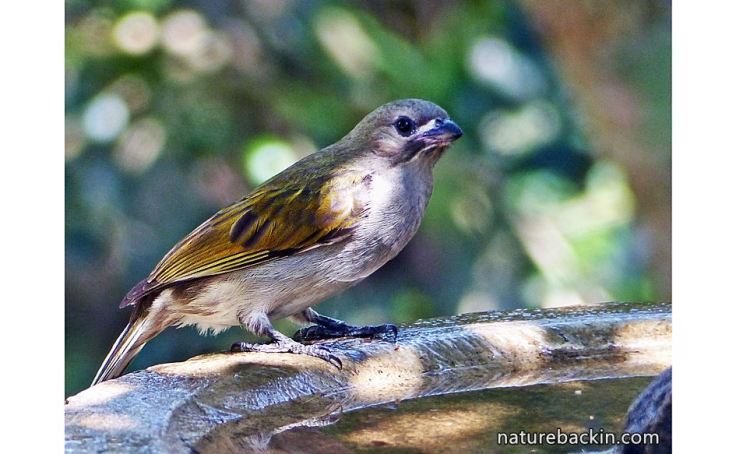
An adult Lesser Honeyguide at a birdbath in our garden
After an old partially decaying tree in our garden that the Barbets were nesting in fell down, we hung a homemade nesting log in another tree in the garden. The nesting log was investigated by Olive Woodpeckers and by Black-collared Barbets, but nobody moved in.
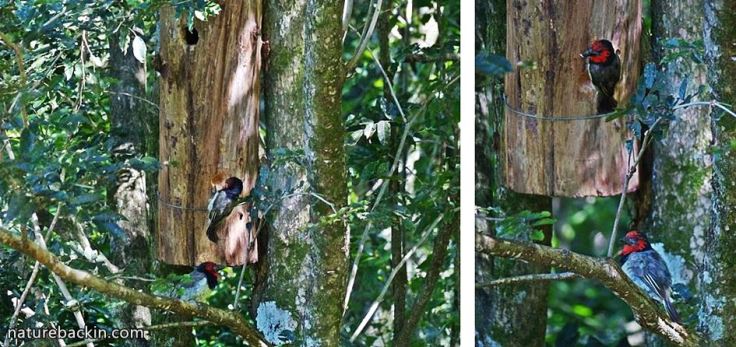
After some months a pair of Black-collared Barbets arrived and busily started excavating a new hole in the log, rather than using the hole provided

Taking turns, they started excavating the log in several places before giving up, deciding to move on to another tree with a dead branch that they made a nest in. A breeding pair may have nest helpers, who even help excavating new nests
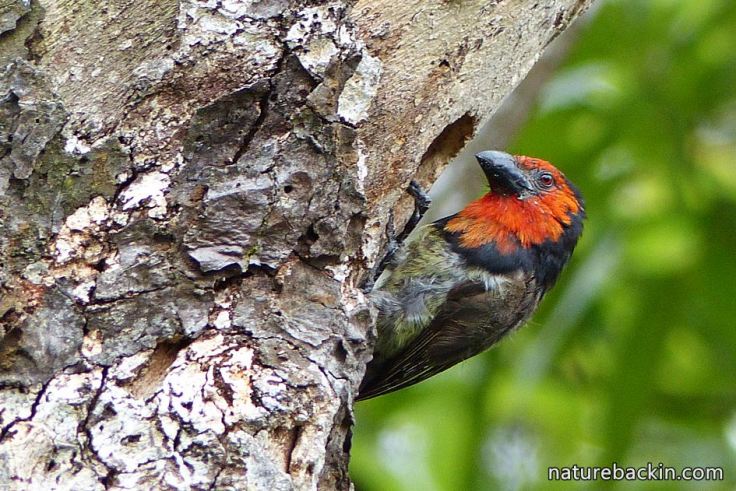
This Barbet spent a lot of time over several days, excavating the beginnings of a nest in another tree, before moving on. It seems strange that they expend such a lot of effort starting to make nesting holes that are then rejected

The Barbet hangs on with both feet while vigorously excavating the nest hole with its strong bill, often throwing up small flurries of “sawdust”
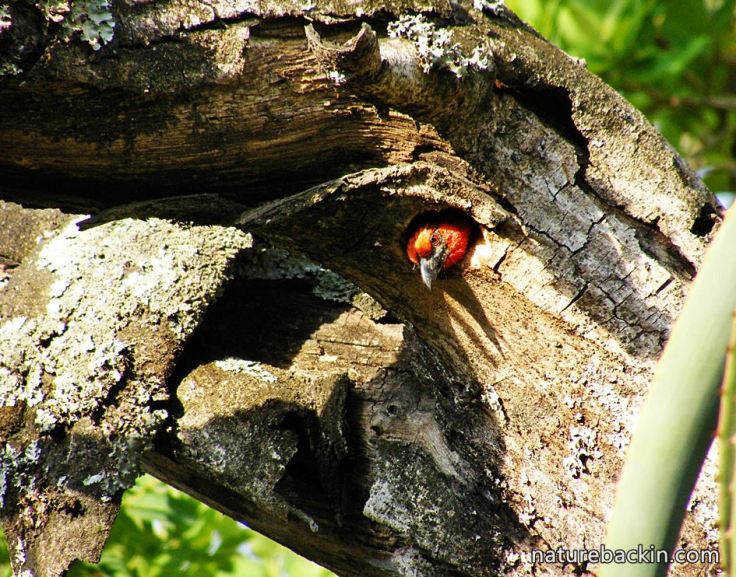
This Barbet is snugly peeping out of the nesting hole. This nest was in the old tree that eventually fell down because of rotting at its base. Fortunately for the Barbets, it was not breeding season when the tree fell down
Barbets can use the same nesting holes for many years. They sometimes roost communally, often with their own offspring.
Black-collared Barbets are found in woodlands and forests and also gardens where fruiting trees occur. Their main food is fruits, but they also eat insects and nectar. These colourful birds are a very busy and vocal presence in the garden.

This photo, taken through our dining room window, shows a Black-collared Barbet foraging for fruits in the Tree Fuchsia (Halleria lucida)
Source: Roberts VII Multimedia PC Edition. 1997-2016 Southern African Birding. http://www.sabirding.co.za/roberts7/portal.html
Posted by Carol

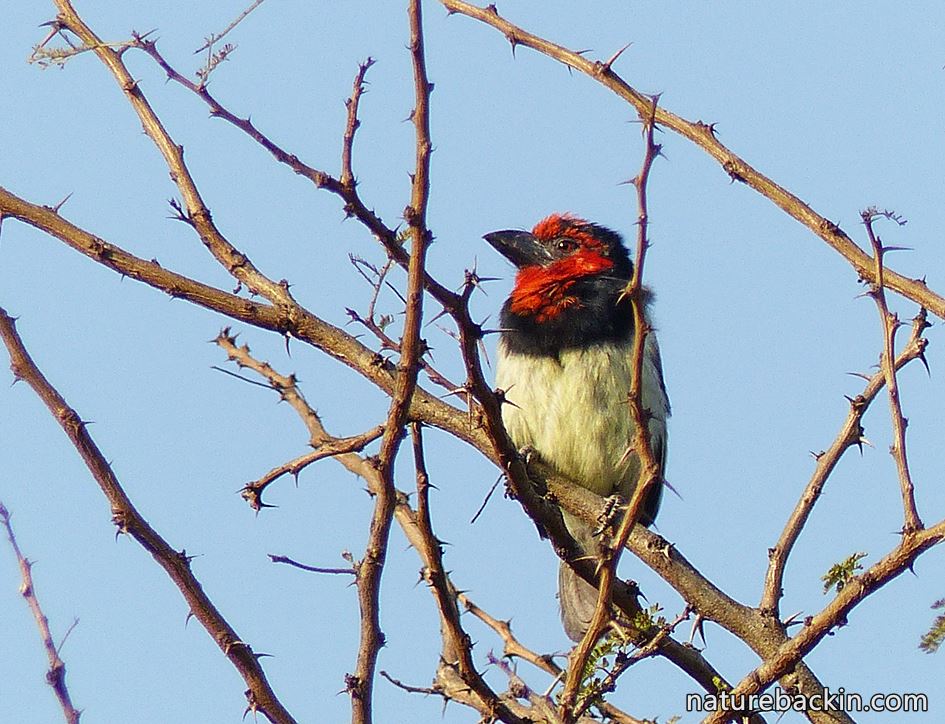







June 16, 2018 at 11:14 pm
Interesting post and photos, you wondered why this bird is not named for its bright red-head, this is probably because there is a red-faced barbet in East Africa that is all black with a red face and throat and the brown-breasted barbet there also has a red-face and head and there are several other African barbets with red on the face. Calling it a red-headed barbet would only really make sense in Southern Africa where there are no other red-headed barbets. In East Africa where these birds also occur the black-collar is a more obvious distinguishing feature, also albeit very rarely these birds can have a yellow-face and head. I’ve always loved these birds for their evocative calls.
LikeLiked by 1 person
June 16, 2018 at 11:43 pm
Actually I made mistake in my previous comment, just to confuse matters the red-faced barbet is all black but it only has a small amount of red on the face, whereas the closely related black-billed barbet is all black with an entirely red face and throat. It just goes to show that bird names are confusing and don’t always make sense.
LikeLiked by 1 person
June 17, 2018 at 10:31 am
Indeed, I can see how the black-billed barbet further adds to the complexity! Thanks so much for your informative and interesting comments. As confusing as common names can be, I am happy that they are used even by serious birders as I really struggle to remember (and even pronounce) scientific names!
LikeLike
June 17, 2018 at 10:27 am
Thanks for your interesting comment and for alerting me to my regional-centric question! I have looked up both the red-faced barbet and the brown-breasted barbet (that do not occur here) and can see how the black collar is distinctive in this company 🙂
LikeLike
May 8, 2018 at 4:01 pm
We just had a family of 5 of these lovely birds move into a tree trunk type nest we bought . So exiting to have seen them prepare the nest and tonight their first night as our new neighbors
LikeLike
May 10, 2018 at 8:14 pm
That’s great! I am sure they will make interesting neighbours and I hope they manage to raise their young successfully when the time comes.
LikeLike
October 30, 2017 at 11:19 am
I’ve been trying to guess of the barbets I watched when visiting S Africa.
And I’ve never seen the Lesser Honeyguide.
LikeLike
October 24, 2017 at 6:13 pm
What fascinating birds! I’d never heard of them before.
LikeLiked by 1 person
October 25, 2017 at 8:16 am
Thanks – glad the post conveyed something of how fascinating they are 🙂
LikeLike
October 20, 2017 at 4:26 pm
Gorgeous birds. I’ve been trying to think of the barbets I watched when visiting S Africa. I don’t think it was these striking birds. Those beaks look capable of serious excavating!
LikeLiked by 1 person
October 20, 2017 at 7:16 pm
Yes the bills do look most formidable. I wonder if you saw the Crested Barbet when you were visiting South Africa? They can be quite conspicuous. We don’t get them in our garden, but they are often around on the drier side of town.
LikeLike
October 21, 2017 at 5:28 am
Yes! I’ve just taken a quick look and it was indeed the crested barbet I have seen. Thank you Carol!
LikeLiked by 1 person
October 21, 2017 at 5:57 am
☺
LikeLike
October 20, 2017 at 2:42 pm
I was just reading about the corvids, specifically the New Caledonian crows, and their affinity for play, sometimes with no particular outcome or reward. Perhaps nest-building is a form of “play” for these black-collared barbets? These photos really capture the beauty of their plumage.
LikeLiked by 1 person
October 20, 2017 at 7:14 pm
Thanks very much for the comment. We do tend to overlook “play” in animals and birds, so that is an interesting possibility. I have seen Black-collared Barbets taking turns excavating holes, but also one that seemed to be working alone, over a period of a few days.
LikeLike
October 20, 2017 at 12:59 pm
Superb collections of photos, Carol.
We have the Barbets at our spot – both local varieties -but never observed them nesting. I should probably by a nesting log, this might help.
And I’ve never seen the Lesser Honeyguide. I wonder if it ever visits?
LikeLiked by 1 person
October 20, 2017 at 7:11 pm
Thanks Ark. It’s possible the Lesser Honeyguide is around where you are. I am not sure I would have noticed them here had there not been the ongoing war around the Black-collared Barbet’s nesting site that was close to our house.
LikeLike
October 20, 2017 at 8:25 am
Those are impressive bills! I would call them red balaclavas if I was naming them …
LikeLiked by 1 person
October 20, 2017 at 7:05 pm
The red certainly is balaclava-esque 🙂
LikeLiked by 1 person
October 20, 2017 at 6:46 am
A lovely read, especially as we too have been watching (and listening to) a pair of Black-collared Barbets in our garden. While Margaret has a point about the distinction of the black collar, I have – like you – felt the red head is the more positive identifier. Apropos the hole-making: I wonder if actually making/starting a hole is part of the breeding instinct – akin to weavers starting a nest and abandoning it only to start another nearby. The calls of the Barbets can be heard from far off and form part of what I consider the iconic sounds of this country – along with the fish eagle.
LikeLiked by 1 person
October 20, 2017 at 7:03 pm
Thanks for your thoughtful comment. I wonder if the species was named for the black collar before or after the very rare form with the yellow (instead of red) head was known about. The breeding and nest making of these Barbets is complicated by the fact that a breeding pair can have nest helpers that also help make nest holes, and also several breeding pairs can share a nesting hole – but I am finding it difficult to find much information on the communal nesting/breeding. I agree that, along with the Fish Eagle, the call of the Black-collared Barbets can be considered to be iconic.
LikeLike
October 19, 2017 at 10:23 pm
Great photos, Carol. I wonder if the barbets excavate some and let it rot over a year for return for another brood? A lot of woodpeckers seem to waste time when nest-building. around here, too.
LikeLike
October 20, 2017 at 5:38 am
Thanks Eliza. The nest holes we have seen them start and abandon we have not seen them return to even years later. Strangely, Weavers too make nests and then tear them down without using them. I guess there are dynamics going on that we humans are oblivious of?
LikeLike
October 20, 2017 at 4:49 pm
Nature’s many mysteries.
LikeLiked by 1 person
October 19, 2017 at 9:22 pm
A great photo essay on the Barbet. Very interesting, Carol.
LikeLiked by 1 person
October 20, 2017 at 5:29 am
Thank you Sandy. Raising young and all that entails seems to be hugely challenging for most birds.
LikeLiked by 1 person
October 20, 2017 at 3:47 pm
My casual observation would say you are correct. Birds overcome many obstacles in the process of fledging their young each year.
LikeLiked by 1 person
October 19, 2017 at 9:03 pm
Oh, I think the name is fair. The red head wouldn’t be as striking without that black collar to accentuate it and set it off. I look forward to your weekly natural history lessons.
LikeLiked by 1 person
October 20, 2017 at 5:23 am
Thanks Margaret. I take your point re the collar ☺
LikeLike